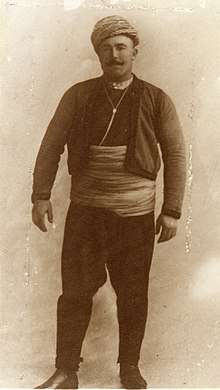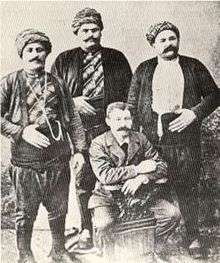Yusuf İsmail
Yusuf İsmail (1857 – July 4, 1898), also known as Youssouf Ishmaelo, was a Turkish professional wrestler who competed in Europe and the United States as Yusuf Ismail the Terrible Turk during the 1890s. During his lifetime, native Turks knew him as Şumnulu Yusuf Pehlivan. However, writer Rıza Tevfik posthumously awarded him the honorific Koca ("Great"), and thus he was later remembered as Koca Yusuf.
| Yusuf İsmail | |
|---|---|
 | |
| Born | 1857 Village of Karalar, near Shumen, Özü Eyalet, Ottoman Empire |
| Died | July 4, 1898 (aged 40–41)[1] off Nova Scotia, Canada |
| Professional wrestling career | |
| Ring name(s) | Yusuf Ismail, the Terrible Turk |
| Billed height | 6 ft 2 in (1.88 m) |
| Billed weight | 305 lb (138 kg) |
| Billed from | Shumen, Ottoman Empire |
| Debut | 1894 |
Known for his massive size and brute strength, he was recognized as one of the top three strongmen in the world by Alan Calvert, a pioneer of American weight training, and photographer Edmond Desbonnet during the turn of the century. Prior to his arrival in the United States, he remained undefeated in his near four-year career and successfully challenged Evan "Strangler" Lewis for the American Heavyweight Championship in 1898. Yusuf Ismail was the original wrestler to be known as "the Terrible Turk", but several others, including Kızılcıklı Mahmut (promoted as his son)[2] and Armenian-American Robert Manoogian, also used the name throughout the first half of the 20th century.
Biography
Early career and the "Turkish Invasion"

Little is known of his early life prior to his first wrestling appearance in 1894, however, according to Scottish wrestling historian William Baxter, Yusuf Ismail was born Youssuf Ishmaelo in Bulgaria (then part of the Ottoman Empire) in 1857 to a Muslim Turkish family. Ismail first came to prominence when he won the Kırkpınar Tournament in 1887. Edmond Desbonnet claimed in his book Les Rois de la Lutte (1910) that the Turkish invasion began in 1894 after a wrestler named Joseph Doublier was defeated by a rival, Sabès. In search of someone who could defeat Sabès, Doublier visited Turkey and brought back three wrestlers: Kara Osman, Nurullah Hasan, and the 6'2", 250-pound Yusuf Ismail. Doublier had also brought Katrancı Mehmet Pehlivan and Kurtdereli Mehmet Pehlivan to Paris a while before. In his Paris debut, Ismail defeated Sabès in four seconds. Sabès had attempted to use a front belt hold, but Ismail withstood the hold and pinned him using a chokehold.[3]
Ismail spent the next three years in France, where he dominated opponents. A colorful figure, he was also known for his fierce pride. When rivals Antonio Pierri and Tom Cannon threatened to bring in a wrestler to defeat him, Ismail reportedly said he would cut his own throat if he was ever beaten. His match against another fellow Turk, Ibrahim Mahmut, was said to be one of the "most brutal bouts ever seen on the mat" at the Cirque d'Hiver in Paris. Ismail became so enraged during the match that he tore at Mahmut's nostrils, broke his ribs, and twisted his arms. Although referee Tom Cannon had attempted to stop the match, only the intervention of a police inspector and six officers along with several spectators were able to separate the two. Kara Osman had been originally scheduled to face Ismail but had fallen ill, and Mahmut had taken his place. According to a rumor heard by French promoter Joseph Doublier, Osman had actually withdrawn from the match because he feared for his life because of an unspecified grudge between Ismail and himself.[3]
Tour of the United States
He continued to be managed by Doublier until 1898, when Antonio Pierri took him to New York. Taken on by promoter William A. Brady, the two appeared at the London Theatre in New York, offering $100 to anyone who could stay in the ring with him for 15 minutes. George Bothner, a well known lightweight wrestler, was the only one to accept the challenge. Although outweighed by Ismail by at least 100 pounds, Bothner claimed that "there wasn't a man alive who could pin him on his back in 15 minutes" and accused Ismail of being an impostor "like so many other so-called terrors". Despite his bravado, Bothner was defeated by Ismail several days later and suffered a neck injury during the match. He described their encounter years later to Nat Fleischer in his book From Milo to Londos (1937):
He was a modern Hercules and he knew how to apply his punishing strength, as he was as quick as a jungle cat and master of all holds. Youssuf came at me like a bull. He rushed me right off the mat into a bunch of chorus girls in the wing. The first thing I knew I found myself helpless. The Turk picked me up as if I was a kitten. Never before have I felt such terrible strength. Before I could give a wiggle or squirm he dashed me down on the boards with terrific force, knocking all the strength and wits out of me... They told me that after I had landed, Youssuf rolled me over with his foot, looked out over the audience, gave a contemptuous snort and walked off the stage. When I came to, I was a sadder, but wiser young man. Somehow or other I got into my clothes, hobbled out into the street and started to walk up Third Avenue towards my home. Youssuf had given my neck such a wrench that he almost tore it from my shoulders. It was several days before I could look in the direction I was headed.
He was undefeated prior to his arrival in New York until his disqualification in a match against World Greco-Roman Heavyweight Champion Ernest Roeber at Madison Square Garden on March 26, 1898.[4] Ismail, who may have intentionally fouled himself, caused the crowd to riot when he pushed Roeber out of the ring, a raised platform, and caused him to fall headfirst onto the ground five feet below. Roeber was unconscious for several minutes, and many in the crowd believed he had been killed, causing spectators to charge into the ring. Only a small police guard under Chief of Police John H. McCullagh were able to block the crowd from entering.
Roeber was revived after a few minutes and examined by physicians for injuries. Having landed on his shoulder, it was announced that he had suffered a back injury and it was decided that he would not be able to continue. Referee Hugh Leonard awarded the match to Roeber and, with calls to "Kill the Turk" and threats of lynching from those in attendance, Ismail was escorted by police to his dressing room. Ismail's manager, William Brady, offered to stage an exhibition bout between Ismail and Tom Cannon, but McCullagh refused to allow the event to continue due to concerns of rioting.[5] The match was described in the 1907 novel The Substitute: A Football Story by sports writer Walter Camp.[6]
A rematch between Ismail and Roeber was held at the Metropolitan Opera House on April 30. During the bout, the two began a shoving match, which caused their managers, William Brady and Martin Julian, to enter the ring. Brady and Julian, who also managed rival heavyweight boxing champions Jim Corbett and Bob Fitzsimmons, began arguing over the management of their respective men. When Fitzsimmons attempted to intervene, several fans stormed the ring and referee Herman Wolff declared the match a no-contest before the event could once again end in a near-riot. Opera House management closed the venue to wrestling events soon after.[4]
Months later, Ismail defeated Evan "Strangler" Lewis for the American Heavyweight Championship in Chicago, Illinois. Lewis was neither able to overcome Ismail's massive size and strength nor manage to use his sleeper hold during the match. Ismail had the $5,000 prize money converted to gold and carried it in a money belt along with the title.[7]
Death
Shortly after his victory over Lewis, Ismail took the first ship back to Europe, where he reportedly planned to open a coffee or bazaar in his native village near Shumen. It was on the ill-fated SS La Bourgogne that he was one of the 600 passengers who drowned when the ship sank on the morning of July 4, 1898. According to colorful accounts from the New York press, Ismail fell overboard while passengers were being evacuated to the lifeboats. Dragged underwater by the weight of his money belt, supposedly containing between $8,000 and $10,000 in gold coins, he drowned before the crew could get to him.[8][9][10] Other journalists and surviving passengers claim to have seen "the Terrible Turk" throw women and children overboard trying to reach the lifeboats; however no mention of this was included in the official report and is generally assumed to have originated by Ismail's manager and promoter William Brady, who went on to become a successful Broadway producer.[3][11]
See also
- List of people who disappeared at sea
Championships and accomplishments
References
- "The "Terrible Turk" Lost". Classic Wrestling Articles. Retrieved 19 August 2015.
- Kızılcıklı Mahmut Pehlivan
- Noble, Graham (2003-05-23). "The life and death of the Terrible Turk". Eurozine.
- Sprechman, Jordan and Bill Shannon. This Day in New York Sports. Champaigne, Illinois: Sports Publishing LLC, 1998. (pg. 86, 121) ISBN 1-57167-254-0
- "Yousouf Fouled Roeber; "The Terrible Turk," Angered by the German-American's Tactics, Pushed Him from the Platform. RIOTOUS OUTBREAK FOLLOWED Chief of Police McCullagh and a Cordon of Officers Necessary to Get the Big Wrestler Safely to His Dressing Room in Madison Square Garden". New York Times. 1898-03-27.
- Camp, Walter (1909). The Substitute: A Football Story. New York: D. Appleton and Company. pp. 123–125.
- Brubaker, Paul W. (September–October 1985). "The Bread Basket: The Terrible Turk". Brethren Revival Fellowship.
- "Ismail Youssouf, "The Terrible Turk" Obituary". Evening Wisconsin. 1898-07-29. Archived from the original on 2006-01-10.
- Incredible but True. New Delhi: Pustak Mahal, 1992. (pg. 14) ISBN 81-223-0350-1
- Swindoll, Charles R. Growing Strong in the Seasons of Life. Grand Rapids, Michigan: Zondervan Publishing House, 1994. (pg. 295) ISBN 0-310-42141-1
- Bloom, Ken. Broadway: Its History, People, and Places: An Encyclopedia. New York: Taylor & Francis, 2004. (pg. 79) ISBN 0-415-93704-3
Further reading
- Brady, William A. (1937). Showman. New York: E.P. Dutton & Co.
- Davis, Robert H.; Cobb, Irvin S. (1926). Over My Left Shoulder: A Panorama of Men and Events, Burlesques and Tragedies, Cabbages and Kings and Sometimes W and Y. New York: D. Appleton and Company.
External links
- KocaYusuf.org, official website about Koca Yusuf
- "Commemorative Coins issued by Turkish Mint". Archived from the original on December 13, 2007.
- Deceased Superstars - Youssuf Ishmaelo
- CageMatch.de - The Terrible Turk (in German)